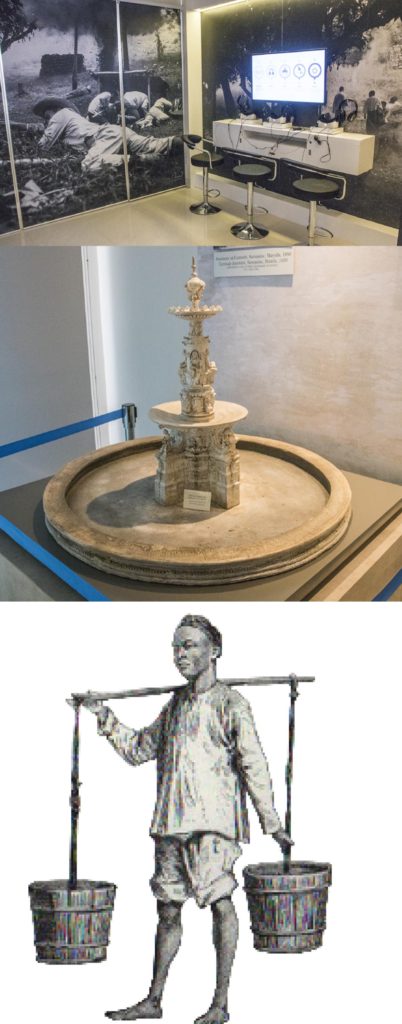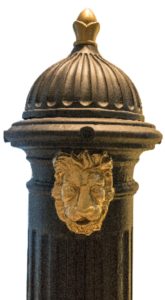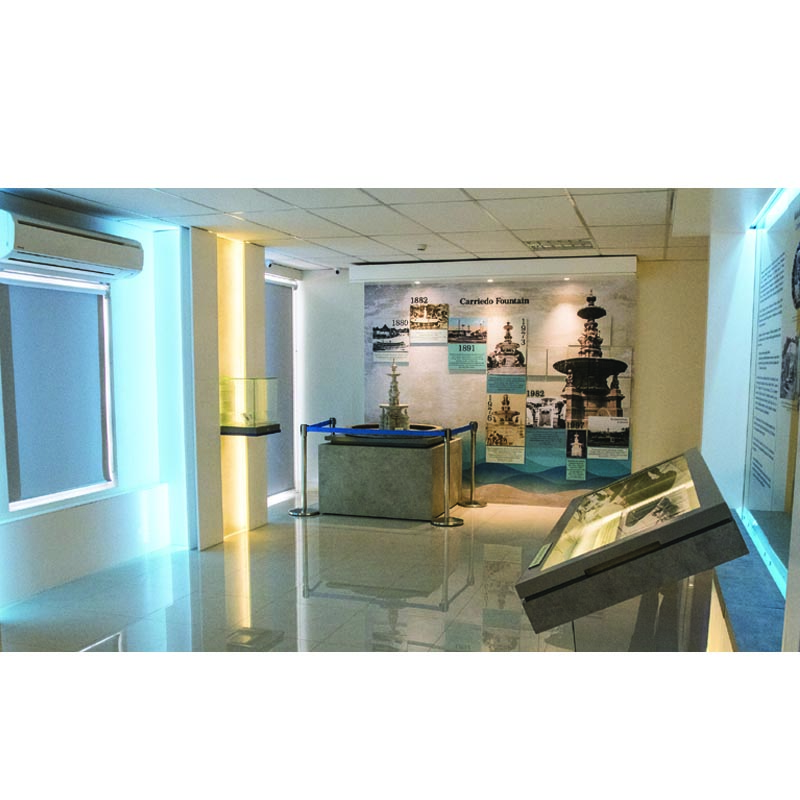
Have you ever wondered what it takes to quench the thirst of a city as big as Manila? Well, you can stop wondering about it when you visit the Museo El Deposito, one of the latest museums built and operated by the National Historical Commission of the Philippines at various historical sites across the country.
The museum, which opened on Feb. 18 at the site of the city’s first underwater reservoir in San Juan City, is more than just a story of how Manila got its first waterworks system – it also tells how our fight for independence began.
The exhibit inside this two-storey building consists of three galleries: audio-visual room, resource room and virtual reality room.

The audio-visual room on the ground floor sets the stage by explaining what life was like before Manila had a proper waterworks system. Before the 1880s, water was delivered to homes by aquadores or water carriers. They would carry the water in a tinaja (clay jar), balanced on their shoulders with a bamboo pole, similar to what taho vendors do today. Back then, how much people pay for the water depends on where it was sourced. The water that comes from the Pasig River was P2.50 per tinaja, but the water from a spring in San Juan went as high as P12.50 per tinaja.
After the audio-visual room, visitors proceed to the resource room on the second floor, where the story continues with archival photos, maps and artifacts. Here, we learn that because of water-borne diseases such as cholera, there was a desperate need for a safe supply of drinkable water for Manila. In addition, because of the danger of house fires, it was necessary for Manila to have a system of working fire hydrants.

Also in the gallery is the tale of Don Francisco Carriedo who arrived in Manila as a shipment supervisor on the galleon Sacre Familia. He stayed on, got married and made a fortune on the Manila Acapulco galleon trade.
Perhaps as a way of paying back for his good fortune, he made a sizeable donation of P10,000 to the city in 1733 to help kick start its first waterworks system. Unfortunately, his donation failed to attract attention and the project never pushed though.
Instead of taking back the money, Carriedo kept it in an iron chest with the keys held by the mayor of Manila and two other city officials. This endowment came to be known as the Caja de Carriedo.
After Carriedo died in 1743, people forgot about the money in the chest although he mentioned it in his will. However, Carriedo’s story at the museum did not mention about the will being discovered in 1865 by a Franciscan monk, Father Felix Huerta. With compounding interest, the amount in the chest had grown to P177,834.
But as big as this amount was, it was still not enough to build a waterworks system. To get more funds, a royal order was issued ordering the city of Manila to donate P100,000 and a tax was imposed on meat consumption.
Construction on the waterworks began in 1872 under the supervision of Spanish engineer and architect Genaro Palacios. He chose the Mariquina River in Santolan as the source for Manila’s water. The pumping station was built on what is now Camp Atienza in Santolan. Through a network of pipes, the water was pumped from the station to the underground water reservoir in El Deposito in San Juan. The pipe route from Santolan to San Juan later became the basis of what is now Santolan Road.
The route of the waterworks back then had to pass through the haciendas of the Augustinians and Dominican monks, as well as the Tuazon family. It is not known if the Augustinians and the Tuazon family asked the authorities for a fee for using their lands. But the Dominican stated on record that they did not require any payment for using their land. Because of this, they were entitled to free water from the Carriedo system when it opened.
It was these network of pipes that led to a street in San Juan being called Calle Tuberias. In fact, part of the stone aquaduct in San Juan was still there up until the early 2000s, before it was demolished. There was another Calle Tuberias in Quiapo but that has long since been renamed as Concepcion Aguila St.
By 1882, the Carriedo Water Works was completed at the cost of P745,590. The underground reservoir was capable of storing 56,000 cubic meters of water, which was more than enough for Manila’s population of 285,454. (By comparison, Angat Dam, which supplies water to Metro Manila today, has a capacity 850 million cubic meters.) The waterworks also provided water for Manila’s network of 153 fire hydrants.
To honor his generosity, a fountain was set up in Sampaloc in Carriedo’s name. Since then, the fountain’s location has changed around the metropolis several times. It is presently located in front of Santa Cruz Church.

A replica of one of Manila’s earliest fire hydrant.
Because of his involvement with the waterwork project, Palacios was asked to help in rebuilding the San Sebastian Church. He suggested that the church be rebuilt with steel and not with stone.
As to how the site came to be known as El Deposito: In the Spanish language, the word deposito can mean either a ware reservoir or depot. That was because aside from the water reservoir, the area was also the site of the Spanish military ammunition dump and armory. It was because of this that when the Philippine revolution broke, El Deposito’s armory and reservoir, as well as the nearby El Povorin (the gunpowder depot), became the target of the katipuneros. The battle came to be known as the Battle of San Juan del Monte, the first real battle of the Philippine revolution.
The battle took place at dawn of Aug. 30, 1896, with Andres Bonifacio leading 800 katipuneros in an attempt to take over both El Deposito and El Povorin. To give visitors a better understanding of how the battle unfolded, the museum set up a special room where visitors can don virtual reality goggles and headsets, enabling viewers to take part vicariously in the battle itself. The whole reenactment is performed in Filipino with English subtitles.

But that is not all that the museum has to offer. One part of the museum is still under construction: the former under water reservoir itself. Museo El Depositio curator Ayesha Sayseng said they have drained and cleaned the reservoir. Extending to 150 meter in length, the tunnel would make for a cool concert venue or a movie location shoot.
Sayseng also said that while they plan to reopen the tunnel as a tourist attraction, they have not yet decided if the tunnel could be used for other purposes. Their present concern is building a proper stairway and an elevator leading to the site. They are also waiting for methane levels to go down so it will be safe to enter the tunnel.
As yet, there is no set date when the tunnel will be opened to the public, but when it does open, it is sure to be one of the coolest new attractions of San Juan’s Pinaglabanan Memorial Shrine.
Museo El Deposito – Pinaglabanan Memorial Shrine is located in San Juan, Metro Manila. For more information, call 0995-7794673, 763-5439 or email [email protected]. Museum hours are 8 a.m. to 4 p.m. (Tuesdays to Sundays). Admission is free.
